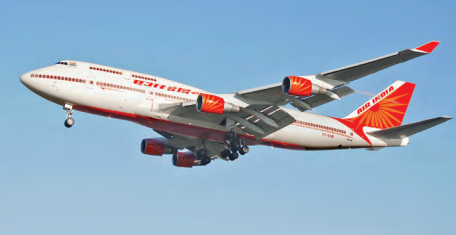Peter Immanuel
Biz@India
June 2017
Aerospace and aviation have always been an aspirational sector in India and I am sure it will continue to attract quality students and workers, highlights a hopeful Immanuel.
Skilling and training in the aviation industry were identified as one of the prime projects of India’s expanding airline market. The Aerospace and Aviation Sector Skill Council (AASSC), established in 2014, has taken up the issue with responsibility and the development plans look impressive for India. In an interview with Biz@ India, Peter Immanuel, the chief executive officer (CEO) of AASSC talks about the emerging developments in the aerospace industry as far as the challenges of skilling one million people in the sector is concerned. Immanuel talks about the key players, imperative roles, and opportunities as well as the road ahead to a sustainable and successful aviation industry in India.
How is skilling emerging in aerospace design and development; aerospace manufacturing and assembly; airline operations; cargo and ground handling; and Maintenance Repair and Overhaul (MRO) in India?
Aerospace and aviation sector is a vast and homogeneous sector. We have categorised the sector into five domains or sub-sectors as you have listed. The first two fall under aerospace category and the last three sub-sectors fall under aviation category. Even though all the five sub-sectors are unique and independent, they are small pockets of functional overlap and interdependencies. Qualification Packs (QPs) for 19 job roles of airlines and eight job roles of MRO have been cleared by National Skill Development Corporation (NSDC) and are open for training partner affiliation. QPs for 11 job roles of airports are with NSDC for approval. About 23 QPs of manufacturing sector are presently under industry validation. QPs for nine job roles of design are being developed by KPMG at the moment. Also, affiliation of assessment bodies to AASSC is under progress.
How have the different stakeholders taken up the challenge of skilling one million persons?
There are primarily two stakeholders in the aviation skill ecosystem. They are the government represented by Ministry of Civil Aviation (MoCA) and the aviation industry represented by airline, airport and MRO companies. MoCA is actively engaged in this initiative in every possible manner. A proposal to set up Aviation Skill Centre in Chandigarh’s old airport leveraging a Memorandum of Understanding (MoU) signed between Airports Authority of India (AAI) and NSDC is under implementation. We are working in a time bound manner to get this operational at the earliest. This will be followed by an Aviation Skill Centre of Excellence (CoE) at Visakhapatnam (south-east India). Bird Academy, which will be one of the training partners under AASSC has signed an MoU to skill 35,000 people over six years.
Industry confederations like MRO Association are engaged with us and talks are on with two European MRO majors to set up Academies for Skill Development in MRO. During AeroIndia 2017, Airbus and government of Telangana signed an MoU with NSDC for CoE in Hyderabad (south India).
How do you assess the progress of AASSC set up in 2014?
AASSC has been operational for a little more than 18 months. The initial challenges were in setting it up from scratch and bringing representatives of the large sector on board. Next, it was the task of National Occupational Standards (NOS) development, which by itself is a huge project. At one end it was meeting the processes and the norms spelt out by NSDC, and at the other end extracting domain knowledge from experts and compiling it in specified format. KPMG had been identified to help us in this project. The process began with the preparation of an occupational map. From this map, which has a list of over 500 job roles, 70 job roles were shortlisted for NOS development, based on demand and criticality. The NOS development was followed by industry validation and vetting by NSDC. It again went to National Skill Development Agency (NSDA) for approval prior to notification.
What steps are being taken up to implement NOS and QPs?
Based on QPs, the curriculum has been developed. Training partner and assessment body affiliation has begun. The training delivery process will commence very soon. This process will involve training of trainers, training of assessors, infrastructure creation by training partners, content development, rolling out of skill programmes, assessment of trainees and certification.
Recently several Multinational Companies (MNCs) are setting up their skilling academies in India in aviation sector. How is this trend shaping up?
In the aviation sector, there is little difference between multi-national and local companies as all of them operate under global standards. All the stakeholders are aware of the challenges. Our role is to ensure that there is adequate skilled manpower to meet the demand. The skill environment will be much different in one to two years from now because of the solid foundation that has been laid and the initiatives that have been taken so far.
How is the council addressing challenge in terms of lack of trainers, high cost of equipment, curriculum, lack of training institutes in aviation and aerospace sector?
National Skills Qualification Framework (NSQF) has brought in a paradigm shift in the skill development scenario in India. One such change is introduction of skill programmes in niche areas, which are job role specific. For example, if you consider job roles like aerospace composite technician or aircraft armament fitter, the knowledge and skills lie embedded with Subject Matter Experts (SMEs) or employees of few companies.
That is why role of Sector Skill Council, which is an industry led body, is crucial. Being an industry supported body, we are tapping all resources and networks to roll out training of trainer programmes and to create content. The other characteristics of our skill ecosystem, being high capex and high tech oriented, reinforce the need for systematic and organised skill development efforts.
How far has the sector been able to attract quality students for undergoing skilling for different programmes in the aerospace and aviation sector?
Aerospace and aviation sectors have always been aspirational. I am sure it will continue to attract quality students and workers. It should be appreciated that skill programmes are not only needed at the supply side i.e., schools, colleges and Industrial Training Institutes (ITIs), but also very much at the demand or corporate side in terms of entry level training, upskilling and reskilling. Therefore, our skill development centres and training partners will address the needs of both the sides.
AASSC has set a target to certify 520,000 trainees and 6,000 qualified instructors over the next 10 years.
I am sure that the 10-year target will be met by the council. The Sharada Prasad Committee report has called for merger of AASSC and Automotive Skills Development Council. In its place, it has recommended auto and transport manufacturing skill sector council.
The report has made this recommendation on the assumption that AASSC caters purely for manufacturing sector. But aerospace and aviation is an integrated and homogeneous sector right from design and production of aircraft to operation, support services like airports and ground handling to life cycle maintenance through MRO services. Domains other than manufacturing have not been considered while making this recommendation. Even between the aerospace sector and automotive sector there is no one-is-to-one similarity. For example, automotive industry operates in six sigma paradigm while aerospace industry works under zero defect model. The aerospace and aviation sector is governed by totally different set of safety and regulatory norms mandated by different national and global bodies. The governing council of AASSC had deliberated it thoroughly and the concerns have been conveyed.











